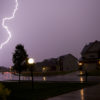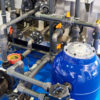What You Need to take care of a green pool water problem:
- A deep Leaf Net
- Sturdy pool brush- make sure your bristles are still strong and all there
- Pool Acid – 3 Gallons
- Calcium Hypochlorite (Granular Pool Shock) – 5 pounds
- Pool Bleach – 10 Gallons
- Check your Cartridge Filter Element for Need of Replacement
Step 1 Remove Debris
If your pool is full of organic material it will take more chemicals and time to turn it around. First, we recommend using a deep, sturdy leaf net vs. a shallow leaf net that only cleans floating leaves off the surface. They won’t be sturdy enough to pull debris from the pool floor which is key in getting your pool back to swimming condition. Have a trash can(s) nearby for the debris to ensure that they don’t end up falling back in your pool.
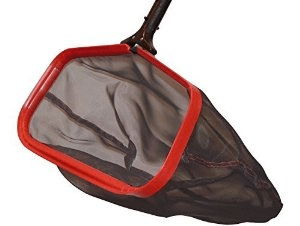
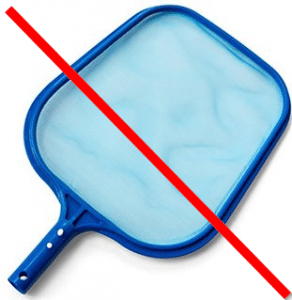
Step 2 Add Chemicals
Your pool is probably a green cloudy mess, so you’ll want to add two chemicals to begin the clearing process:
- Pool Acid – also known as Muriatic Acid
- Pool Bleach (bought in the big yellow jugs) also known as Sodium Hypochlorite
It’s important to wear eye protection, appropriate clothing, and gloves to protect your skin when dealing with these two chemicals.
First, add 1.5 gallons of the pool acid to the pool. The goal of the pool acid is to drive down the pH of the water so that the chlorinating compound will be effective. As a tip, pour the acid slowly behind you into the pool while walking on the poolside. Be aware of the pool deck and surroundings to avoid spilling the acid. Once the acid is added triple rinse the one empty jug putting the first two rinses in the pool.
Next, add the pool bleach. The jug should have an air cap (small cap) and a dispensing cap (large cap). Remove both and pour into the shallow end of the pool. Repeat with three whole jugs or 7.5 gallons of pool bleach. Follow the same precautions with eyewear and gloves, avoid splashes and rinse any area that gets bleach on it thoroughly with water. Rinse the jugs at least twice with the first rinse going back in the pool.
Once the chemicals are in, it’s time to get the water moving. If your pool has a recirculate mode on the multiport that’s what we want. With the system off, put the multiport to recirculate and turn on the system. This will bypass your filter and just move the water.
Step 3 – Circulate & Brush
If you have a cartridge filter element, you can watch our video to see how to properly clean your cartridge filter element. You can achieve similar results in recirculating by removing the cartridge filter and running your system without it.
While you let the chemicals work, we suggest you clean your old cartridge element even if you end up replacing it. Set both the new one and the old one aside for use later.
After about 30 minutes of water circulation with the chemicals in the pool, brush the pool floors and walls. Your brush should be in good shape and strongly backed with metal.
Expect your pool to turn into a cloudy green/blue mess but do your best to brush everything – floors, walls, and steps, even though you can’t see. When you are done brushing turn the system off at the breaker so the water doesn’t start circulating accidentally.
Step 4 – Add More Chemicals
Add the rest of the open acid container approximately ½ gallon, and then broadcast 3 to 4 pounds of granular calcium hypochlorite over the bottom of the pool. To distribute, you should open the bags into a clean dry bucket and with a gloved hand broadcast (throw underhand sideway away from you like throwing a Frisbee) the granular product across the pool so it sinks and covers the pool floor.
When done, double rinse the bucket and gently pour the rinses into the pool, try not to disturb the settling calcium hypochlorite. Now we want the pool to settle out so the best thing to do is leave your pool overnight and let the chemicals to do their job.
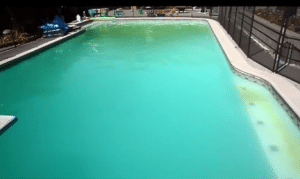
Step 5 – Evaluate Your Pool Water
You’ll need to evaluate your pool the morning after adding chemicals, so go take a look at your pool. Your pool might look like one of these photos. Brush a small spot to see if the Algae is dead. It comes up in a cloud if it’s dead, it streaks in place if it’s alive.
As long as the Algae is dead we move forward. “how to vacuum the pool with green algae?”
If the algae is still alive you need to go back to Step 2 and repeat the process (you may need to buy more chemicals). If this happens more than once, having to go back and not killing the algae, you need to stop and call a pool service professional to come test your water to determine your next steps.
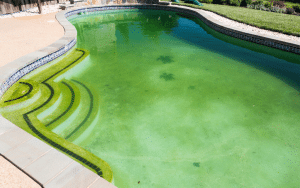
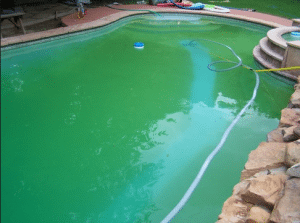
Is your pool just cloudy? check this blog: How Do I Fix Cloudy Pool Water.


